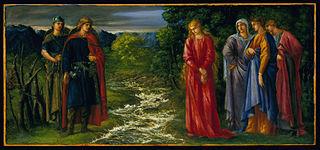 W
WBrattahlíð, often anglicised as Brattahlid, was Erik the Red's estate in the Eastern Settlement Viking colony he established in south-western Greenland toward the end of the 10th century. The present settlement of Qassiarsuk, approximately 5 km (3.1 mi) southwest from the Narsarsuaq settlement, is now located in its place. The site is located about 96 km (60 mi) from the ocean, at the head of the Tunulliarfik Fjord, and hence sheltered from ocean storms. Erik and his descendants lived there until about the mid-15th century. The name Brattahlíð means "the steep slope". The estate, along with other archeological sites in southwestern Greenland, was inscribed on the UNESCO World Heritage List in 2017 as Kujataa Greenland: Norse and Inuit Farming at the Edge of the Ice Cap
 W
WHvalsey is located near Qaqortoq, Greenland and is the site of Greenland's largest, best-preserved Norse ruins in the area known as the Eastern Settlement (Eystribyggð). In 2017, it was inscribed on the UNESCO World Heritage List and part of the Kujataa Greenland site.
 W
WIvittuut, formerly Ivigtût is an abandoned mining town near Cape Desolation in southwestern Greenland, in the modern Sermersooq municipality on the ruins of the former Norse Middle Settlement.
 W
WSandnæs, often anglicized as Sandnes, was the largest Norse farmstead in the Western Settlement of medieval Greenland. Similarly with the Norwegian city of Sandnes, its name meant "Sandy Headland" in Old Norse. It was settled around AD 1000 and abandoned by the late 14th century. It was located at the site known as Kilaarsarfik today, at the head of the Ameralla Fjord south of modern Nuuk's peninsula.
 W
WGunnlaugs saga ormstungu or the Saga of Gunnlaugur Serpent-Tongue is one of the Icelanders' sagas. Composed at the end of the 13th century, it is preserved complete in a slightly younger manuscript. It contains 25 verses of skaldic poetry attributed to the main characters.
 W
WGutasaga (Gutasagan) is a saga regarding the history of Gotland before its Christianization. It was recorded in the 13th century and survives in only a single manuscript, the Codex Holm. B 64, dating to ca. 1350, kept at the National Library of Sweden in Stockholm together with the Gutalag, the legal code of Gotland. It was written in the Old Gutnish language variety related to Old Norse.
 W
WThe Jómsvíkinga saga (Saga of the Jomsvikings) is a medieval Icelandic saga composed by an anonymous Icelander. The Saga was composed in Iceland during the 13th century. It exists in several manuscripts which vary from each other. There are many different versions and translations of the saga.
 W
WThe Orkneyinga saga is a narrative of the history of the Orkney and Shetland islands and their relationship with other local polities, particularly Norway and Scotland. The saga has "no parallel in the social and literary record of Scotland" and is "the only medieval chronicle to have Orkney as the central place of action". The main focus of the work is the line of jarls who ruled the Earldom of Orkney, which constituted the Norðreyjar or Northern Isles of Orkney and Shetland and there are frequent references to both archipelagoes throughout.
 W
WSturlunga saga is a collection of Icelandic sagas by various authors from the 12th and 13th centuries; it was assembled in about 1300. It mostly deals with the story of the Sturlungs, a powerful family clan during the Age of the Sturlungs period of the Icelandic Commonwealth.
 W
WSymbel (OE) and sumbl (ON) are Germanic terms for "feast, banquet".